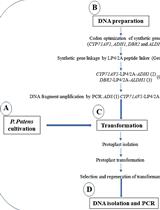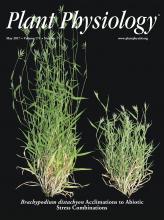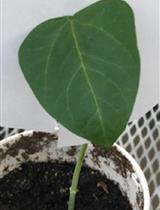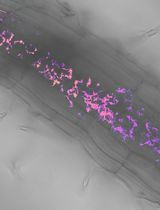- EN - English
- CN - 中文
Radioactive Tracer Feeding Experiments and Product Analysis to Determine the Biosynthetic Capability of Comfrey (Symphytum officinale) Leaves for Pyrrolizidine Alkaloids
放射性示踪剂喂养实验测定紫草(聚合草)叶的吡咯里西啶生物碱生物合成能力及其合成产物的分析
发布: 2018年02月05日第8卷第3期 DOI: 10.21769/BioProtoc.2719 浏览次数: 7190
评审: Venkatasalam ShanmugabalajiAnonymous reviewer(s)

相关实验方案

通过在体内直接组装多个DNA片段在青蒿中异源生产青蒿素
Nur Kusaira Khairul Ikram [...] Henrik Toft Simonsen
2023年07月20日 2214 阅读
Abstract
This protocol delivers a method to determine the biosynthetic capability of comfrey leaves for pyrrolizidine alkaloids independently from other organs like roots or flowers.
The protocol applies and combines radioactive tracer experiments with standard and modern techniques like thin layer chromatography (TLC), solid-phase extraction (SPE), high-performance liquid chromatography (HPLC) and gas chromatography-mass spectrometry (GC-MS).
Background
Comfrey roots are known to be able to synthesize pyrrolizidine alkaloids (Frölich et al., 2007) and the key enzyme for biosynthesis, homospermidine synthase (HSS), was localized in the endodermis cells. In addition to this site of synthesis, there have been hints that also leaves of a certain developmental stage might be able to produce pyrrolizidine alkaloids (Niemüller et al., 2012). Therefore, a protocol was developed to determine the biosynthetic capability of comfrey leaves to synthesize pyrrolizidine alkaloids independently from other plant organs.
Materials and Reagents
- epT.I.P.S® pipette tips (Eppendorf, catalog number: 0030000730 )
- Strata SCX 500 mg/6 ml tubes (Phenomenex, catalog number: 8B-S010-HCH )
- Scintillation vial 4 ml (Carl Roth, catalog number: HEE8.1 )
- 1.5 ml microcentrifuge tube (SARSTEDT, catalog number: 72.706.700 )
- 2 ml microcentrifuge tube (SARSTEDT, catalog number: 72.695.500 )
- Scalpel (Carl Roth, catalog number: AH88.1 )
- Microcapillary pipette, volume 1-5 µl (Sigma-Aldrich, catalog number: Z611239 )
- Silica gel G-25 TLC plates 20 x 20 cm (Merck, catalog number: 1003900001 )
- Verex Vial Kit 9 mm, µVial i3 (Phenomenex, catalog number: AR0-9974-12 )
- Hamilton syringe 25 µl (Hamilton, catalog number: 80400 )
- Fresh comfrey leaves from a flowering plant (size about 3.5 cm in length)
- Liquid nitrogen
- [1,4-14C]Putrescine (3.95 GBq/mmol, Amersham Int., catalog number: CFA.301, since the end of Amersham Int., [1,4-14C]Putrescine is still available at PerkinElmer, catalog number: NEC150000MC )
- [12C]Putrescine (Carl Roth, catalog number: 4141.2 )
- Scintillation cocktail, Rotiszint eco plus (Carl Roth, catalog number: 0016.3 )
- Acetonitrile (Carl Roth, catalog number: 7330.1 )
- Methanol (Carl Roth, catalog number: P717.1 )
- Ammonia solution 30% (Carl Roth, catalog number: CP17.1 )
- Sulphuric acid solution volumetric, 0.05 M (VWR, catalog number: 319589-500ML )
- Zinc dust (Carl Roth, catalog number: 9524.2 )
- Sodium hydroxide (NaOH) (Carl Roth, catalog number: 6771.1 )
- Potassium phosphate dibasic (K2HPO4) (Carl Roth, catalog number: T875.1 )
- Potassium phosphate monobasic (KH2PO4) (Carl Roth, catalog number: P018.1 )
- [14C]Retronecine
Note: It was prepared according to Lindigkeit et al., 1997 and Hartmann et al., 2001. - Ethyl acetate (Carl Roth, catalog number: 6784.1 )
- 2-Propanol (Carl Roth, catalog number: 9866.2 )
- 5% ammonia in methanol (see Recipes)
- 100 mM phosphate buffer, pH 7.5 (see Recipes)
- Mobile phase TLC (see Recipes)
Equipment
- Pipettes (Eppendorf, model: Research® plus, catalog number: 3123000063 )
- Microscale
- Fume hood (Thermo Fisher Scientific, catalog number: 1363 )
- Vacuum manifold for SPE (Agilent Technologies, catalog number: 5982-9110 )
- Lamp (Carl Roth, catalog number: 2986.1 )
- Mortar and pestle (Carl Roth, catalog number: NT80.1 )
- Vortex shaker (IKA, model: Vortex 2 )
- Micro stir bars (Carl Roth, catalog number: 0955.1 )
- Magnetic stirrer (IKA, model: lab disc [white] )
- Optima 1 MS GC column (MACHEREY-NAGEL, catalog number: 726205.15 )
- Minispin Microcentrifuge (Eppendorf, catalog number: 5452000018 )
- Radioactivity thin-layer-chromatography detector (RITA, Raytest, Straubenhardt)
- Tri-Carb 2910 TR LSC Low Activity Liquid Scintillation Analyzer (PerkinElmer)
- LiChrograph HPLC (Merck-Hitachi) connected to a fraction collector Pharmacia Frac-100 (GE Healthcare Life Science)
- EC 250/4 NUCLEOSIL® 120-5 C18 HPLC column (MACHEREY-NAGEL, catalog number: 720041.40 )
- Developing chambers for TLC (Carl Roth, catalog number: 3133.1 )
- Shimadzu GC-2010 gas chromatograph with SSL injector (Shimadzu, model: GC-2010 )
- Shimadzu AOC-20i Auto-injector (Shimadzu, model: AOC-20i )
- Fisons MD 800 quadrupole mass spectrometer
Software
- XCalibur 1.1 (Thermo Fisher Scientific, Dreieich, Germany)
- GinaStar TLC (Raytest, Straubenhardt)
- QuantaSmartTM 4.0 (PerkinElmer)
Procedure
文章信息
版权信息
© 2018 The Authors; exclusive licensee Bio-protocol LLC.
如何引用
Readers should cite both the Bio-protocol article and the original research article where this protocol was used:
- Stegemann, T., Kruse, L. H. and Ober, D. (2018). Radioactive Tracer Feeding Experiments and Product Analysis to Determine the Biosynthetic Capability of Comfrey (Symphytum officinale) Leaves for Pyrrolizidine Alkaloids. Bio-protocol 8(3): e2719. DOI: 10.21769/BioProtoc.2719.
- Kruse, L. H., Stegemann, T., Sievert, C. and Ober, D. (2017). Identification of a second site of pyrrolizidine alkaloid biosynthesis in comfrey to boost plant defense in floral stage. Plant Physiol 174(1): 47-55.
分类
植物科学 > 植物新陈代谢 > 其它化合物
生物化学 > 其它化合物 > 生物碱
您对这篇实验方法有问题吗?
在此处发布您的问题,我们将邀请本文作者来回答。同时,我们会将您的问题发布到Bio-protocol Exchange,以便寻求社区成员的帮助。
Share
Bluesky
X
Copy link











